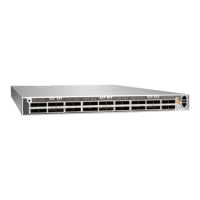CAUTION: Do not leave a ber-opc transceiver uncovered except when inserng or
removing cable. The safety cap keeps the port clean and prevents accidental exposure
to laser light.
6. Arrange the cable in the cable management system to prevent the cable from dislodging or
developing stress points. Secure the cable so that it is not supporng its own weight as it hangs to
the oor. Place excess cable out of the way in a neatly coiled loop in the cable management system.
Placing fasteners on the loop helps to maintain its shape.
CAUTION: Do not let ber-opc cable hang free from the connector. Do not allow
fastened loops of cable to dangle, which stresses the cable at the fastening point.
CAUTION: Avoid bending ber-opc cable beyond its minimum bend radius. An arc
smaller than a few inches in diameter can damage the cable and cause problems that
are dicult to diagnose.
7. Verify that the status LEDs on the indicate that the QSFP28 is funconing correctly.
Remove a Transceiver
Before you remove a transceiver from a device, ensure that you have taken the necessary precauons
for the safe handling of lasers (see Laser and LED Safety Guidelines and Warnings).
Ensure that you have the following parts and tools available:
• An anstac bag or an anstac mat
• Rubber safety caps to cover the transceiver and ber-opc cable connector
• A dust cover to cover the port or a replacement transceiver
NOTE: Aer you remove a transceiver, or when you change the media-type conguraon, wait
for 6 seconds for the interface to display the operaonal commands.
Figure 48 on page 119 shows how to remove an SFP+ or QSFP+ transceiver.
To remove a transceiver from a device:
117

